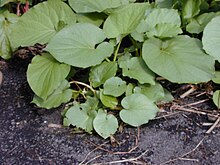Root Beer Plant
Search
Wikipedia
| Piper auritum | |
|---|---|

| |
|
Scientific classification | |
| Kingdom: | Plantae |
| Clade: | Tracheophytes |
| Clade: | Angiosperms |
| Clade: | Magnoliids |
| Order: | Piperales |
| Family: | Piperaceae |
| Genus: | Piper |
| Species: |
P. auritum
|
| Binomial name | |
|
Piper auritum | |
| Synonyms | |
|
Piper sanctum[1] | |
Piper auritum is an aromatic culinary herb in the pepper family Piperaceae, which grows in tropical Central America. Common names include hoja santa (Spanish for "sacred leaf"),[2]yerba santa,[3][4]hierba santa,[3]Mexican pepperleaf,[4]acuyo,[4]tlanepa,[4]anisillo,[4]root beer plant,[2]Vera Cruz pepper[5] and sacred pepper.[1]
Description
It is a perennial herbaceous plant with heart-shaped velvety leaves. The leaves can reach up to 30 centimeters (12 in) or more in size. The complex flavor is not so easily described; it has been compared to eucalyptus,[6][7]licorice,[2][8]sassafras,[3][9]anise,[4][10]nutmeg,[4]mint,[11][12]tarragon,[6] and black pepper.[4] The flavor is stronger in the young stems and veins.
It is native to the Americas, from northern South America to Mexico, and is also cultivated in southeast Florida and California.
Usage
It is often used in Mexican cuisine in tamales, fish or meat wrapped in its fragrant leaves for cooking, and as an essential ingredient in mole verde, a green sauce originally from the Oaxaca region of Mexico.[3] It is also used to flavor eggs and soups like pozole.[13] In Central Mexico, it is used to flavor chocolate drinks.[4] In southeastern Mexico, a green liquor called verdín is made from hoja santa.[14] It is also used for tea. In some regions of Mexico, goat cheese is wrapped in hoja santa leaves and imbued with its flavor.
While typically used fresh, it is also used dried, although the drying process removes much of the flavor and makes the leaf too brittle to be used as a wrapper.[15]
Chemistry / Constituents
The leaf oil of Piper auritum contains a relatively high concentration of safrole, around 70%. A few of the other 40 constituents occurring in minor quantities were α-thujene, α-pinene, camphene, β-pinene, myrcene, and limonene.[16]
Safrole, a substance also found in sassafras, has been shown to be carcinogenic in animals. In 1960, the U.S. Food and Drug Administration banned sassafras bark along with sassafras oil and safrole as flavoring agents because of their carcinogenic properties[13] and the Council of Europe imposed the same ban in 1974,[17] with the EPA classifying the compound as a group B2 probable human carcinogen. While there are no adequate studies elucidating the relationship between exposure to safrole and human cancers, safrole-DNA adducts, an indicator for safrole-induced carcinogenicity, have been found in tissues from esophageal cancer patients.[18][non sequitur or poorly related / irrelevant]
References
- ^ a b Barlow, Prof. Snow (2003). "Sorting Piper names". University of Melbourne. Retrieved 2007-03-29.
- ^ a b c Rolland, Jacques L. (2006). The Food Encyclopedia: Over 8,000 Ingredients, Tools, Techniques and People. Robert Rose. p. 326. ISBN 0-7788-0150-0.
- ^ a b c d Miller, Mark Charles (1993). Coyote's Pantry: Southwest Seasonings and at Home Flavoring Techniques. Ten Speed Press. p. 70. ISBN 0-89815-494-4.
- ^ a b c d e f g h i Katzer, Gernot (2012). "Gernot Katzer's Spice Pages - Mexican Pepperleaf (Piper auritum Kunth)". Retrieved 2012-12-03.
- ^ "Piper auritum". Natural Resources Conservation Service PLANTS Database. USDA. Retrieved 6 October 2015.
- ^ a b "Ingredient - Hoja Santa". The Washington Post. 2004-08-18. Retrieved 2007-03-29.
- ^ Pyles, Stephan (1999). New Tastes from Texas. Three Rivers Press. p. 214. ISBN 0-609-80497-9.
- ^ Raichlen, Steven (2000). Steven Raichlen's Healthy Latin Cooking: 200 Sizzling Recipes from Mexico, Cuba, Caribbean, Brazil, and Beyond. Rodale Books. p. 26. ISBN 0-87596-498-2.
- ^ Lambert, Paula (2000). The Cheese Lover's Cookbook and Guide: Over 150 Recipes with Instructions on How to Buy, Store, and Serve All Your Favorite Cheeses. Simon & Schuster. p. 43. ISBN 0-684-86318-9.
- ^ Davidson, Alan (1999). The Oxford Companion to Food. Oxford University Press. p. 383. ISBN 0-19-211579-0.
- ^ Hale, Adrian J.S. (2006-09-28). "Craft, not Kraft, is the key to these homeland treats". Orlando Weekly. Archived from the original on 2006-11-14. Retrieved 2007-03-29.
- ^ Nordin, Donna (2001). Contemporary Southwest: The Cafe Terra Cotta Cookbook. Ten Speed Press. p. 19. ISBN 1-58008-180-0.
- ^ a b Creasy, Rosalind (2000). The Edible Mexican Garden. Tuttle Publishing. p. 35. ISBN 962-593-297-6.
- ^ Conner, Lori (2006). "El Restaurante Mexicano (May/June 2006): Beyond margaritas". Maiden Name Press LLC. Archived from the original on 2007-04-20. Retrieved 2007-04-01.
- ^ Bladholm, Linda (2001). Latin & Caribbean Grocery Stores Demystified. Renaissance Books. p. 106. ISBN 1-58063-212-2.
- ^ Gupta, Mahabir P.; Arias, Tomás D.; Williams, Norris H.; Bos, R.; Tattje, D. H. E. (March 1985). "Safrole, the Main Component of the Essential Oil from Piper auritum of Panama". Journal of Natural Products. 48 (2): 330–330. doi:10.1021/np50038a026.
- ^ Contis, E.T.; et al., eds. (1998). Food Flavors: Formation, Analysis and Packaging Influences (Developments in Food Science). Elsevier. p. 403. ISBN 0-444-82590-8.
- ^ Jang-Ming Lee et al., Safrole–DNA adducts in tissues from esophageal cancer patients: clues to areca-related esophageal carcinogenesis, Mutation Research/Genetic Toxicology and Environmental Mutagenesis, Volume 565, Issue 2, 2005, Pages 121-128, ISSN 1383-5718

